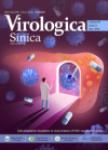The Saffold Virus-Penang 2B and 3C Proteins, but not the L Protein,Induce Apoptosis in HEp-2 and Vero Cells
The Saffold Virus-Penang 2B and 3C Proteins, but not the L Protein,Induce Apoptosis in HEp-2 and Vero Cells作者机构:Temasek Life Sciences Laboratory1 Research LinkNational University of SingaporeSingapore 117604Singapore Department of Microbiology and ImmunologyYong Loo Lin School of MedicineNational University Health SystemNational University of SingaporeSingapore 117545Singapore Department of Biological SciencesNational University of SingaporeSingapore 117543Singapore Institute of Molecular and Cell BiologyA*STAR (Agency for ScienceTechnology and Research)Singapore 138673Singapore
出 版 物:《Virologica Sinica》 (中国病毒学(英文版))
年 卷 期:2019年第34卷第3期
页 面:262-269页
核心收录:
学科分类:0710[理学-生物学] 07[理学] 09[农学]
基 金:funded by Temasek Lifesciences Laboratory an affiliate of National University of Singapore and Nanyang Technological University Singapore and did not receive any specific grant from any funding agency in the public commercial or not-for-profit sectors
主 题:Saffold virus(SAFV)Apoptosis Viral proteins
摘 要:Our previous work has shown that Saffold virus(SAFV)induced several rodent and primate cell lines to undergo apoptosis(Xu et *** Emerg Microb Infect 3:1-8,2014),but the essential viral proteins of SAFV involved in apoptotic activity lack *** this study,we individually transfected the viral proteins of SAFV into HEp-2 and Vero cells to assess their ability to induce apoptosis,and found that the 2B and 3C proteins are *** investigation indicated the trans-membrane domain of the 2B protein is essential for the apoptotic activity and tetramer formation of the 2B *** research provides clues for the possible mechanisms of apoptosis induced by SAFV in different cell *** also opens up new directions to study viral proteins(the 2B,3C protein),and sets the stage for future exploration of any possible link between SAFV,inclusive of its related uncultivable genotypes,and multiple sclerosis.




